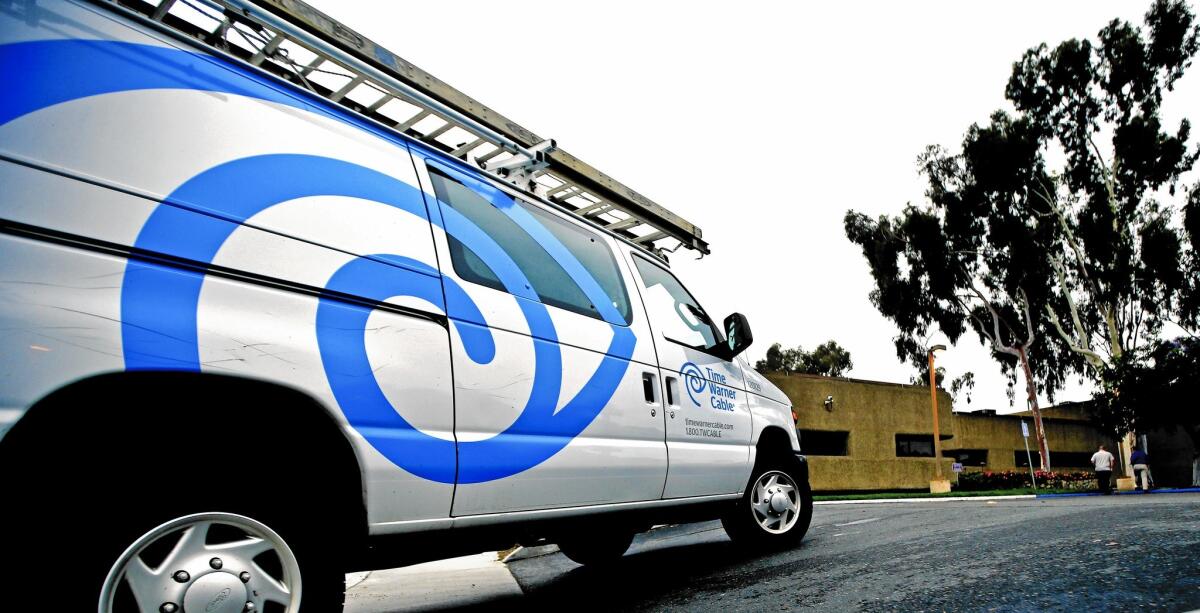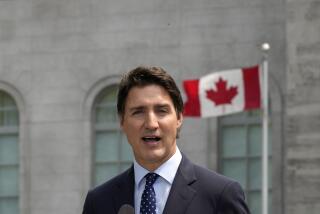Want control over your cable bill? Move to Canada.

- Share via
It’s not that Canada is perfect. It’s just that Canadians are really good at dealing with important things.
Take your pick — healthcare, gun control, same-sex marriage, political donations — the Canadians have proved themselves capable of having grown-up discussions and finding reasonable, common-sense solutions.
Down here, it’s business as usual, even if that business routinely fleeces consumers.
SIGN UP for the free California Inc. business newsletter >>
Case in point: If you’re a Time Warner Cable customer, you may have noticed that your monthly bill — yet again — is going up. For instance, the “broadcast TV and sports programming surcharge” is rising to $8.75 a month from $5.50. That’s nearly a 60% increase.
Other pay-TV companies also have jacked up rates in what’s become an annual ritual for the industry.
North of the border, meanwhile, our Canadian friends are preparing for the introduction March 1 of what’s being called “pick and pay,” a new system that will allow pay-TV subscribers to receive only the channels they want.
I sat down the other day with the Canadian government, in the person of James Villeneuve, consul general in Los Angeles. I wanted to know why Canada seemed to have no difficulty stepping up on behalf of consumers when U.S. officials can’t seem to get past the dithering phase.
“It’s fair to say we take a consumer-centric approach to things,” Villeneuve said.
He cited the example of cigarette packages, which are now required to devote 75% of the front and back to graphic health warnings and, if the newly elected government has its way, soon also will do away with brand designs and logos.
The switch to a-la-carte pay-TV channels similarly indicates a willingness to disrupt the corporate status quo.
Jean-Pierre Blais, head of the government’s Canadian Radio-television and Telecommunications Commission, said the new system “reflects what we have heard from Canadians,” who “expressed frustration that to access a particular channel, they had to pay for a station they did not want.”
Think about that. Canadians “expressed frustration” about being treated unfairly. So the government did something about it.
Under the new system, pay-TV companies such as BCE and Rogers Communications, Canada’s largest cable providers, will be required to offer an “entry-level television service” costing no more than $25 a month. It will feature local and educational channels.
Beyond the base service, Canadians will be able to create their own viewing experiences by subscribing to individual channels or small bundles of channels that, by regulation, must be reasonably priced.
Exact prices remain unknown. Canada’s CBC News reported the other day that none of the major cable and satellite companies has yet revealed how much they’ll charge when pick-and-pay programming is introduced in three weeks.
See more of our top stories on Facebook >>
It speculated that pay-TV companies want to milk customers for as long as possible before revealing that they’ve been taken to the cleaners for years.
John Penney, chief strategy officer of the Starz premium channel, said at a broadcast-industry conference in Ottawa last week that U.S. pay-TV companies are closely watching Canada’s a-la-carte “grand experiment” to see how it affects prices and program diversity.
“Canada will provide data that will allow all of us to see how things are,” he told me Monday. “There’s going to be a lot to learn here.”
The lessons for U.S. industry seem clear enough. Just ask Torrance resident Pauline Kosanke, 75, who has been a Time Warner Cable subscriber for about two decades.
When she saw that her bill is going up again, she called the company to plead for mercy.
“I’ve done that before and they lowered the bill a little,” Kosanke said. “This time, no go. Absolutely impossible, they said.”
She figures she watches maybe a dozen channels, which means she’s paying for hundreds that she doesn’t want. That’s pretty much par for most viewers. According to Nielsen, the typical U.S. pay-TV subscriber watches only about 17 channels on a regular basis.
Kosanke is especially aggrieved about the higher mandatory fee for sports programming. “I never watch sports,” she said. “Why do I have to pay for this?”
Dennis Johnson, a Time Warner spokesman, said the higher rates “reflect our continued investment in the performance and reliability of our networks and equipment, along with the rapidly rising costs of programming, especially local broadcast channels and cable sports networks.”
In other words, Time Warner has to pay more for channels that many people don’t watch, so it’s passing along the cost to all its customers. This is exactly what was so frustrating for Canadians.
Villeneuve, the Canadian consul, said pay-TV companies carped a bit when the government unveiled its pick-and-pay plan. “Then they adjusted,” he said.
Just like that?
Villeneuve smiled politely.
“There’s a certain civility in Canada,” he said. “Industry comes to the table and we have open and honest discussions about jobs and the economy. Ultimately, it’s about what’s best for society.”
Like I say, Canada’s not perfect. But it’s hard not to be impressed.
David Lazarus’ column runs Tuesdays and Fridays. He also can be seen daily on KTLA-TV Channel 5 and followed on Twitter @Davidlaz. Send your tips or feedback to david.lazarus@latimes.com.
MORE FROM DAVID LAZARUS
As Time Warner Cable crows, I’m cutting the cord
Martin Shkreli isn’t alone in ripping off patients with crazy drug prices
Why is the UC system investing in a payday lender accused of trapping people in perpetual debt?
More to Read
Inside the business of entertainment
The Wide Shot brings you news, analysis and insights on everything from streaming wars to production — and what it all means for the future.
You may occasionally receive promotional content from the Los Angeles Times.











